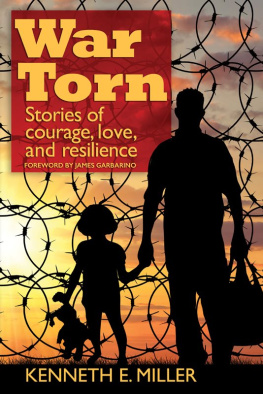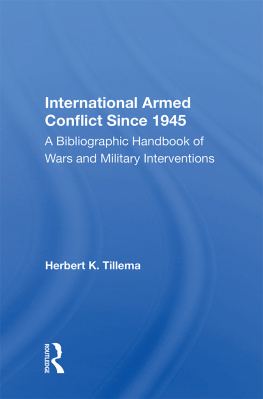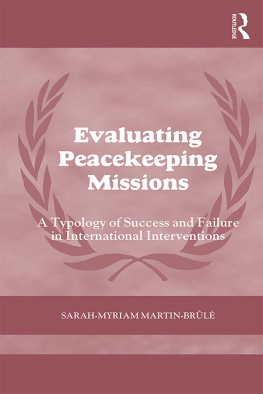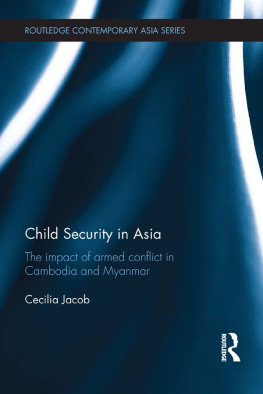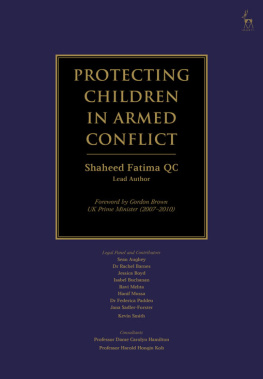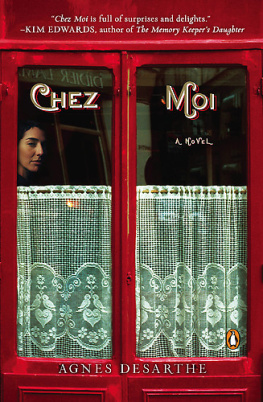CHILDREN AFFECTED BY ARMED CONFLICT
CHILDREN AFFECTED BY ARMED CONFLICT
THEORY, METHOD, AND PRACTICE
Edited by Myriam Denov and Bree Akesson
COLUMBIA UNIVERSITY PRESS NEW YORK
Columbia University Press
Publishers Since 1893
New York Chichester, West Sussex
cup.columbia.edu
Copyright 2017 Myriam Denov and Bree Akesson
All rights reserved
E-ISBN 978-0-231-53967-8
Library of Congress Cataloging-in-Publication Data
Names: Denov, Myriam S., editor. | Akesson, Bree, editor.
Title: Children affected by armed conflict : theory, method, and practice / edited by Myriam Denov and Bree Akesson.
Description: New York : Columbia University Press, [2017] | Includes bibliographical references and index.
Identifiers: LCCN 2017002247 | ISBN 9780231174725 (cloth : alk. paper) | ISBN 9780231174732 (pbk. : alk. paper) | ISBN 9780231539678 (e-book)
Subjects: LCSH: Children and warResearchMethodology. | Child welfareResearchMethodology. | ChildrenResearchMethodology.
Classification: LCC HQ784.W3 C525 2017 | DDC 303.6/6083dc23
LC record available at https://lccn.loc.gov/2017002247
A Columbia University Press E-book.
CUP would be pleased to hear about your reading experience with this e-book at cup-ebook@columbia.edu
Cover design: Chang Jae Lee
Cover image: Jerome Sessini / Magnum Photos
CONTENTS
MYRIAM DENOV AND BREE AKESSON
LUBNA N. CHAUDHRY
NANDITHA HETTITANTRI AND FAY HADLEY
MOLLIE PEPPER
MARIA CAMILA OSPINA-ALVARADO, SARA VICTORIA ALVARADO, JAIME ALBERTO CARMONA, AND HECTOR FABIO OSPINA
JESSICA A. LENZ
BREE AKESSON AND MYRIAM DENOV
KATHLEEN KOSTELNY, KEN JUSTUS ONDORO, AND MICHAEL G. WESSELLS
SUKANYA PODDER
ANGELA VEALE, MIRANDA WORTHEN, AND SUSAN M C KAY
GRACE AKELLO
DEBBIE LANDIS AND LINDSAY STARK
GHADA KACHACHI
JAN STEWART
BREE AKESSON AND MYRIAM DENOV
Our most profound gratitude goes to the children whose lives and experiences are featured in the chapters of this edited collection. We thank them for opening their homes and hearts to researchers like us so we can learn more about their lives in order to work together to prevent and counter the damaging effects of war. We also thank the contributors to this book for their time, commitment, and dedication to this project. We are grateful to them for shining a light on the lived realities of war-affected children from across the globe and for their ongoing efforts to instigate change both conceptually and on the ground, through both theory and practice.
We would also like to thank everyone who helped support this project from its early development through the final stages of production, providing us with vital intellectual and practical help along the way. We are immensely grateful to research assistant Nicole Sawin whose work and commitment to this book were invaluable and unwavering. Nicole meticulously supported us since the beginning and worked her magic to keep us on track. We are also grateful to Dena Badawi, Neil Bilotta, Melissa Fellin, and Kalen Orme for their gracious and effective support and assistance. We would like to extend a special thanks to the staff at Columbia University Pressespecially Jennifer Perillo, senior executive editor, and Stephen Wesley, associate editorfor providing us with continual guidance and supporting our vision for the book. We are also grateful to the anonymous reviewers who provided critical feedback that improved the manuscript.
We would also like to thank the Social Sciences and Humanities Research Council of Canada, the Pierre Elliott Trudeau Foundation, the Fonds de Recherche du QubecSocit et Culture, as well as the Offices of Research Services at McGill University and at Wilfrid Laurier University, for their support and financial and technical assistance, which gave us the opportunity to explore the important intersections of children and armed conflict in our research and writing.
And finally we extend heartfelt thanks to our families for their patience, kindness, and support during the planning and writing of this book.
Myriam Denov and Bree Akesson
Todays global conflicts pose a serious global threat to the well-being of children. More than 230 million children live in 33 conflict-affected countries (UNICEF, 2014), and an estimated 13.5 million children have been internally displaced as a result of war (United Nations, 2010a). According to the United Nations High Commissioner for Refugees (UNHCR, 2015), children comprise 52% of the 59.5 million individuals forcibly displaced by war worldwide. In 2014, there were 40 recorded armed conflictsdefined as one or more states contributing troops to one or both warring sides (Pettersson & Wallensteen, 2015). At the time of writing, the places experiencing the worst humanitarian emergencies as a result of war and political violence include Syria, the Democratic Republic of the Congo, Iraq, South Sudan, Afghanistan, Yemen, the Lake Chad basin, and Libya, while other conflicts, such as in Turkey and Burundi, continue to worsen (Guhenno, 2016).
This increase in armed conflict and political violence has resulted in exceptionally high levels of human suffering. As one example, the protracted conflict in Syria is considered to be the worst humanitarian crisis since World War II, with unprecedented numbers of civilians killed and displaced (Tobia, 2015). Recent conflicts have left millions of children killed, injured, orphaned, or separated from their families; sexually violated; and/or recruited into armed groups (UNICEF, 2012). The homes and communities that children rely on as a source of physical and social protection have often been destroyed, compromising childrens well-being (Akesson, 2014a; Akesson, Basso, & Denov, 2016). Some children fall victim to a general onslaught against civilians; others die as part of a calculated genocide. Severe societal turbulence, the collapse of states, and religious and ethnic conflict, alongside persistent forms of structural violencepoverty, hunger, social exclusion, and discriminationcontinue to underlie childrens involvement in armed violence as victims, participants, and/or witnesses.
Given the importance of this threat and the increasing global concern, there has been a flurry during the last two decades of international research and advocacy for children affected by war. These efforts have focused on three vital areas: conceptual and theoretical debates, methodological questions and concerns, and strategies of appropriate intervention for children, whether during or in the aftermath of armed conflict. Through a stepping back process and reflecting on and discerning trends within this large body of theoretical, methodological, and practice workboth its accomplishments and shortcomingsseveral key elements emerge that deserve further attention.
THEORY
Within the realm of the conceptual, a notable trend has been a research and practice focus on trauma and victimization. Although it is important to acknowledge that children living in or displaced from war zones may witness or directly experience severe and unimaginable violence and upheaval that can have long-term psychosocial impacts (APA, 2010), a great deal of academic literature has focused primarily on childrens maladaptive and antisocial behavior in the aftermath of war, as well as on negative physical and mental health outcomes (Barber & Schluterman, 2009; Derluyn & Broekaert, 2008; Huemer et al., 2011; Lambert & Alhassoon, 2015). Drawing from a romanticized Western conception of childhood and its association with vulnerability and the need for protection, much of the theoretical literature has tended to construct war-affected children as traumatized, dependent, helpless, and objects of assistance, rather than as agents of their own welfare (Denov, 2010; Honwana & de Boeck, 2005).




